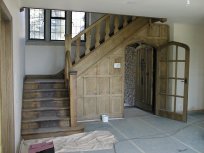|
In these days of increasing house prices and the costs
associated with moving it is an increasingly attractive option to
extend or alter your home.
We can provide expert
assistance with your project from inception to
completion.
From outline
design to overseeing the builders. A typical
project would involve the steps below.
You may have thought a great deal
about your project before you approach a surveyor or architect.
You may have know exactly what you want, or you may be looking for
ideas from your consultant. Whatever your situation we always
suggest that you discuss possible alternatives with us. Having
clear vision and focus at the outset will greatly increase the
chances of a successful outcome.
We will take your vision of what you
want and produce outline drawings so that you can see clearly what
your alterations or extension will look like. We can even produce
alternative schemes so that you can compare and contrast before
making a final decision.
Throughout the process we will have
been advising you of the likely impact on your proposals of the
need to obtain planning permission, listed building consent or
conservation area consent. By this stage we will be ready to
produce all of the drawings and details required to make the
necessary applications.
At this stage we will be looking,
with you, at the detail of the structure, materials and the
practicalities of actually building what you want. We will work up
drawings with sufficient detail to enable them to be submitted for
approval to your local authority building control department. It
is sometimes necessary at this stage to involve a structural
engineer. We can either work with an engineer you choose or we can
suggest engineers we have worked with successfully in the
past.
- Building Regulations
Application
By now we will be ready to make your
building regulations application. On most of our projects we
recommend that a full plans submission is made as this, once
approved, provides a good deal more certainty for you than the
alternative. However, with smaller, simpler works where speed is
essential we can omit this step and use the building notice
procedure. This latter procedure enables the building works to
commence two days after notice has been given, but the building
inspector may insist on changes whilst the works
progress.
The preparation of a specification
and tender documentation is an essential stage to ensure; that the
work is done at competitive prices,
that insofar as possible disputes are avoided, and that if
disputes arise there are fair mechanisms for dealing with them
without the need for disruption of the works. For example it is in
this documentation that the quality of the work is defined. It is
now that we will discuss alternative procurement routes and
contracts with you and explain the risks and benefits of each. The
choice of contract terms is yours, but we will advise you which
contract is most suited to your
requirements.
The drawings and specification are
sent to builders asking them to price the works in competition
with others. The choice of which builders are invited to tender is
yours, however we can help in the selection of likely candidates
if you wish. We are happy to introduce you to builders who we have
worked with successfully in the past, but we do point out that we
do not "recommend" builders to our
clients.
Once the tender documents are
returned we will analyse them and report back to you. As the whole
point of the exercise is to obtain
the best price for the work you will normally want to engage the
most competitive builder. However, our analyses may highlight
issues that cause us to recommend one of the other builders. If
this is the case we will explain our reasons to you. In any event
the choice of builder is entirely
yours.
Really this is a misnomer, surveyors
and architects do not actually supervise the building works, that
is what you are paying the building company to do. More properly
what we do is administer the contract. That means that we visit
periodically to check the progress and quality of the works to
ensure that the builder is doing what he agreed to do in the
contract. If he isn't we will instruct him to do
so.
Administering the contract involves
us wearing two hats. Firstly we are your professional eyes and
ears, looking to ensure that you get what you want, when you want
it. It may involve issuing instructions to the builder to make
changes that you require. There are other matters in which we are
required by law to act fairly and impartially. For example we will
value the works as they progress and certify payments that you
must make to the builder. There are however benefits to you in
this impartiality. Many reputable builders having experienced
working for difficult residential clients simply won't do work for
residential clients unless an architect or surveyor is to
supervise the work. Conversely there are few cowboy builders who
would not be interested in being supervised by a professional, because
poor work will be legitimately rejected and not paid
for.
- Completion and Inherent
Defects
When we think the works are, for all
practical purposes, complete we will issue a certificate to say
so. However, it is the nature of building works that some inherent
problems may take a little while to materialise. For example
plaster may shrink during the first few months and cracks appear
even if the works were done properly. For this reason most
contract define a defects liability period during which some of
the builders money is retained by the client and during which such
defects may be remedied by the builder. In practice this normally
means that for 6 months after the work you retain some money. Near
the end of that time we will talk to you and inspect the works for
any final matters that need to be dealt with. We then instruct the
contractor to deal with them and authorise his final payment once
he has done so.
|

